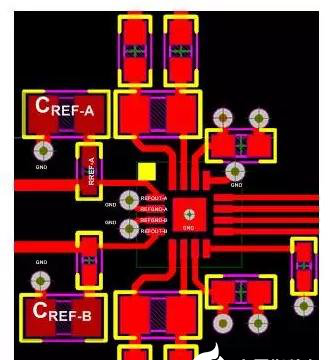How to solve the crosstalk problem in digital-analog hybrid design?
Understanding the basic concepts of design
Many products include designs where different signals have different immunity to interference. In the interconnection design process, the crosstalk between different signals must be properly controlled to ensure the final product's specifications.
Understanding of the following basic concepts is very important. Mastering the basic concepts of design helps to understand the strict layout and wiring design rules formulated later, so that when the digital and analogue design of the end product is mixed, it will not be easily implemented. Important constraint rules. And it helps to flexibly and effectively deal with crosstalk problems that may be encountered in digital-to-analog mixed design.
1. The important difference between anti-interference ability of analog signal and digital signal
Digital signal levels have strong anti-jamming capabilities, while analog signals have poor anti-jamming capabilities.
For example, a 3V digital signal can tolerate even a 0.3V crosstalk signal without affecting the logic state. However, in the field of analog signals, some signals are very weak. For example, the receiving sensitivity of a GSM mobile phone can achieve the index of -110dBm, which is only equivalent to the effective value of a sine wave of 0.7uV. Even receiving in-band interference noise on the order of uV at the LNA front end is enough to significantly degrade the receiving sensitivity of the base station. This slight interference may come from small noise on the digital control signal line or power ground.
From a system point of view, digital signals are generally only transmitted on the board or in the frame.Such as memory bus signals, power control signals, etc., as long as the interference received from the transmitting end to the receiving end is not enough to affect the determination of the logic state. Analog signals need to pass through a series of processes such as modulation, frequency conversion, amplification, transmission, space propagation, reception, and demodulation to be recovered. During this process, the noise keeps falling on the signal. From a system perspective, it must be ensured that the final signal-to-noise ratio meets the requirements in order to demodulate correctly. The biggest interference comes from the attenuation and noise of space propagation. In order to achieve better communication performance, the crosstalk introduced by the interconnection within the board must be minimized.
Therefore, it can be considered that the crosstalk requirements of analog signals are tens of times higher than digital signals, and it may even reach tens of thousands of times.
2. High-precision ADC and DAC circuits
Ideally, the relationship between the signal-to-noise ratio of linear ADC and DAC circuits and the number of conversion bits is:
SNR = 10Log (F2 / N2) = 10Log [A2 / 2 / (A2 / 3 × 2n)] = 6.02n + 1.76 dB
For 14-bit linear ADCs and DACs, if the least significant bit data (LSB) is enabled, the theoretical signal-to-noise ratio can be calculated to be 86dBc. Compared with the crosstalk requirements of digital circuits at about 20dBc, high-precision 14-bit linear ADCs, DACs require at least 1000 times more noise than digital signals. Of course, if only 11 bits are required for the least significant digits, the crosstalk requirement can be lowered appropriately, but it is still much higher than the requirements for digital signals.
The above two cases show that in the digital-analog mixed single board, the analog circuit is extremely susceptible to interference, which will affect the signal-to-noise ratio and other indicators. Therefore, in the design process of digital-analog mixed veneer, high requirements are placed on the layout.

3. Digital signals are a strong source of interference for analog signals
The level of the digital signal is very high compared to the analog signal, and the digital signal contains rich harmonic frequencies. Therefore, the digital signal itself is a very strong source of interference for the analog signal. In particular, high-current clock signals, switching power supplies, etc. are strong interference sources that need attention in digital-analog mixed design.
4. Fundamental purpose of digital-analog hybrid interconnect design
We can understand the problem of digital-analog design in this way. For digital circuits, we follow the design rules of digital circuits. In the area of digital circuits, large interference can be allowed, as long as it does not affect the implementation of system functions and external EMC indicators.
What we mean by "larger" here is relative to analog circuits. For digital circuits, it is not necessary or possible to control the presence of crosstalk as we would with analog circuits. For analog circuits, we must follow the design rules for analog circuits. The interference allowed in the analog circuit area is much smaller than the digital circuit area.
The purpose of the digital-analog hybrid interconnection design is to ensure that digital signal interference exists only in the digital signal area through design methods such as reasonable layout, wiring, shielding, filtering, and power ground division.
What we need to focus on include interference sources, sensitive circuits, and interference pathways. The following will introduce the layout and routing principles from these three aspects. Successful digital-analog mixed veneer design must pay careful attention to every step and every detail in the entire process before it can be realized. This means that thorough and careful planning must be done at the beginning of the design, and every design step The progress of the work will be comprehensively and continuously evaluated. The layout and wiring must be carefully checked and checked to ensure 100% compliance with the layout rules. Otherwise, improper wiring of a signal line will completely destroy a very good circuit board.
Rules are dead. Only by deeply understanding the principles of the rules can we ensure that we can correctly use the rules and complete excellent designs.
If you want to know more, our website has product specifications for the circuits, you can go to ALLICDATA ELECTRONICS LIMITED to get more information

